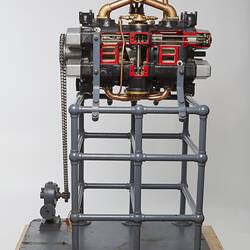Summary
Part of a collection of photographs, negatives and slides used for research by curators at Museums Victoria.
The machine was based on the principles outlined in Anthony George Maldon Michell's Australian Patent No.4627, for "Improvements in Mechanism for the Interconversion of Reciprocating and Rotary Motion", with detailed design supervised by Thomas Louis Sherman, an experienced automotive engineer who worked as Michell's senior design collaborator from 1920. It was originally built as a prototype for consideration by the Victorian Railways to be used for supplying compressed air to operate Westinghouse type brakes on suburban electric trains. According to S.E.A. Walker two similar units were built (assigned Machine Nos.2 & 3 by the firm), but there is no record of the design actually being adopted by the Railways.
Description of Content
First prototype crankless air compressor built by Crankless Engines (Australia) Pty Ltd in 1921, acquired by the Science Museum of Victoria in June 1924 (see ST 015370). Mounted on wooden plinth with cover plates removed for display. Eight-cylinder multistage reciprocating air compressor, rated with a capacity of 80 cubic feet/minute at 100 pounds per square inch, when running at 750 revolutions per minute, or 100 cu.ft/min at 100 p.s.i., when running at 1300 r.p.m.. The machine is double-ended, with four cylinders at each end equally spaced around the centre power shaft, with the axis of each pair of cylinders being parallel to the shaft. It incorporates A.G.M. Michell's famous crankless design utilising a thrust plate or 'slant' (visible through centre opening) in place of a more conventional crankshaft to transmit power from a revolving input shaft to the reciprocating pistons of the compressor.
Physical Description
Black and white silver gelatin photograph.
More Information
-
Collection Names
Museum History Collection, Crankless Engines Collection, A.G.M. Michell Engineering Collection
-
Collecting Areas
Images & Image Making, Public Life & Institutions, Engineering
-
Date Created
-
Organisation Named
Industrial & Technological Museum, 328 Swanston Street, Melbourne, Greater Melbourne, Victoria, Australia, circa 1925
The Michell crankless air compressor (ST 015370) was acquired by the Industrial & Technological Museum in June 1924. -
Manufacturer of Item Depicted
Crankless Engines Ltd, 129 Greeves Street, Fitzroy, Greater Melbourne, Victoria, Australia
-
Inventor
Mr Anthony G. Michell, Melbourne, Greater Melbourne, Victoria, Australia, 1917
The design was based on A.G.M. Michell's Aust. Pat. No.4627, for "Improvements in Mechanism for the Interconversion of Reciprocating and Rotary Motion". -
Format
Photograph, Black & White
-
Inscriptions
Printed in purple ink on back of photograph: 'Industrial & Technological Museum / Melbourne.' Hand written in pencil on back of photograph: 'Michell crankless air compressor / 16th Feb 1925' Hand written in blue ink on back of photograph: 'NO 2634'
-
Classification
-
Category
-
Discipline
-
Type of item
-
Image Dimensions - Photograph
204 mm (Width), 155 mm (Height)
-
Keywords
Air Compressors, Engineering Products, Industrial Design, Innovation & Design, Inventions, Mechanical Engineering, Museum Displays, Museum History, Pneumatic Equipment



